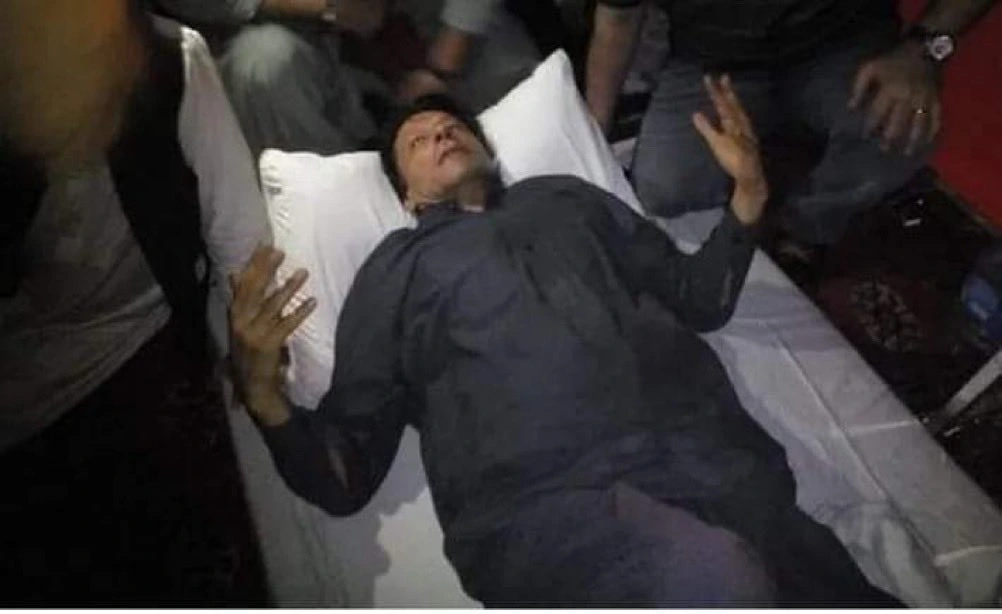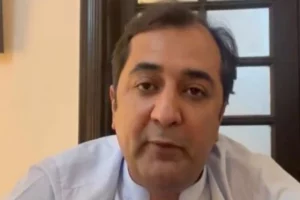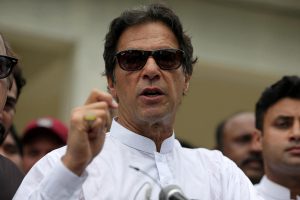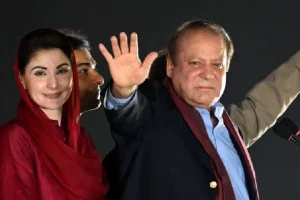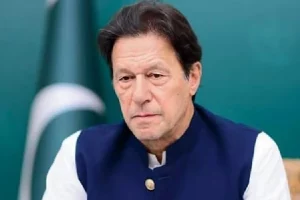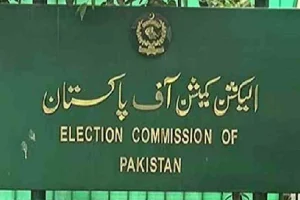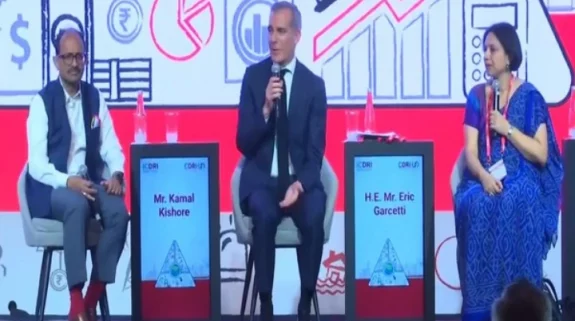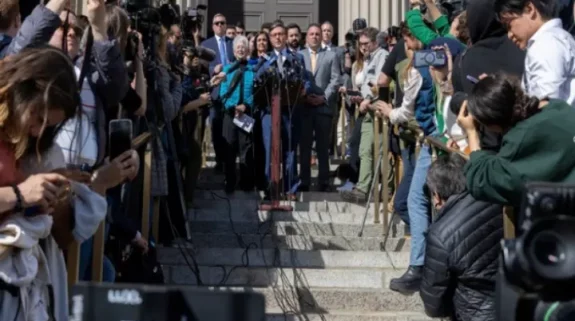The attack by a `lone wolf ‘gunman, Naveed s/o Basheer, on former Prime Minister Imran Khan’s vehicle on the seventh day of the Pakistan Tehreek- e- Insaf (PTI)’s Long March at Allahwala Chowk, Wazirabad on Nov 03 afternoon will intensify the PTI’s confrontation with the ruling Pakistan Democratic Movement (PDM) coalition and the Army establishment.
As many as fourteen persons were injured and one killed in the burst of gunfire, which apparently emanated from a 9 mm pistol. Doubts have been voiced though, that automatic assault weapons could have been used and more than one assailant could be involved. Imran Khan received bullet and shrapnel injuries on his right leg. Others standing close to him like Senator Faisal Javed and Ahmed Nasir Chatha were also seriously wounded, with facial or stomach injuries.
The arrested assailant, Naveed disclosed at the local police station (PS) that he was motivated to take this drastic step as he was mentally disturbed by the manner in which Imran Khan was misleading people and how conservative Islamic mores of conduct like `azaan’ (prayers) were being disregarded. This statement convinced no one. Its disclosure to media within half an hour of his apprehension constituted, in itself, grave professional misconduct on part of the concerned police personnel, leading to their suspension.
The PS falls under jurisdiction of Gujrat district, the home constituency of Punjab Chief Minister, Pervez Elahi. Federal government Ministers did not fail to point this out, stressing repeatedly that law and order remained a provincial responsibility. Elahi did not initially join the chorus of condemnation by PTI leaders but later announced the setting up of a high- level joint investigation team to look into the incident.
A prominent PTI Senator, Ejaz Chaudhary claimed he was aware of an imminent attack on the Long March at Wazirabad, which input he had shared with Ahmed Nasir Chatha the night before. There were intelligence reports suggesting possible attacks of this nature during the Long March but these warnings were either not heeded or did not engender any additional or strict security measures to ward off the danger. By all accounts, security seemed lax around the Container vehicle carrying PTI leaders and counsel to install bullet proof screens was disregarded.
Even from his hospital bed, Imran Khan did not hesitate to raise the stakes of his anti- establishment tirade by naming the Prime Minister, Shehbaz Sharif, Interior Minister, Rana Sanaullah and the Director General, Counter Intelligence at the Inter-Services Intelligence (ISI), Maj Gen Faisal Naseer as those responsible for plotting and executing this attack. This was disclosed to the media by his close henchman, Asad Omar directly after he came out after meeting Imran at the Shaukat Khanum hospital, Lahore where the latter is being treated.
A short while ago, #ImranKhan told us to issue this statement on his behalf.He believes there are 3 people on whose behest this was done-Shehbaz Sharif, Rana Sanaullah & Maj Gen Faisal. He said he was receiving info&is saying this on that basis: PTI’s Asad Umar & Mian Aslam Iqbal pic.twitter.com/84Yn4FSgkD
— ANI (@ANI) November 3, 2022
The Inter Services Public Relations (ISPR), media agency for the military establishment condemned the attack as did other senior politicians of the ruling party. This did not prevent spontaneous outbreaks of angry protests by PTI sympathizers in several major cities of Pakistan. Agitators gathered outside the house of Interior Minister, Rana Sanaullah in Faisalabad and pelted stones. A PTI MNA from Khyber Pakhtunkhwa (KP) claimed, he had organized a dharna (protest) outside the official residence of the XI Corps Commander in Peshawar, Lt. Gen Sardar Hassan Azhar Hayat Khan, known to be close to Army Chief, Gen Bajwa.
Also Read: Pakistan military targeted as Imran Khan’s failed assassination intensifies power struggle
Awareness of possible escalation in these protests, through possible descending on the Capital of hordes of agitating PTI supporters from KP, Gilgit Baltistan/ PoK and Punjab, led the Deputy Commissioner, Islamabad to issue sealing of movement orders in Punjab, under the Pakistan Anti- Terrorism Act, 1958 quoting advice received from the Ministry of Defence vide their letter F No. 4(13)-Defence/ICT dated Nov 3, 2022.
There can be no doubt that this attack on Imran Khan will add to the sympathy wave for the PTI and benefit Imran politically. The Long March had not been drawing as large crowds as had been anticipated at the planning stage. In fact, only a core group of a few hundred die-hard fans were moving with the cavalcade and local PTI organizers were asked to join up, to avoid visual impact of thinning crowds. Imran himself acknowledged this ebbing tide by remarking only a day before, that he would have to stay on in agitational mode in Islamabad during the next ten months, only after which his demand for fresh elections could be conceded.
PTI Chairperson Imran Khan has said that his movement for haqeeqi azadi (real freedom) will continue for the next 10 months as he resumed the party’s long march from Gujranwala on Day 6.
For more: https://t.co/KN5bQwxYjN#etribune #news #PTI #ImranKhan pic.twitter.com/TE32kxmyoa
— The Express Tribune (@etribune) November 2, 2022
The judicial noose was also tightening, as hearings before the hitherto sympathetic Supreme Court Chief Justice, Omar Ata Bandial on the alleged contempt and violations of Court orders on the May 25 demonstrations seemed to indicate. Imran and his party had been forced into a cul de sac.
All this may now change. Though former Information Minister, Fawad Chaudhry has claimed that the Long March will continue, this would depend on how quickly Imran recuperates from his leg injury. Without his physical presence, the Long March may peter out.
Two main types of conspiracy theories abound about the incident. One is that about a self-inflicted `false flag’ operation, to garner sympathy against the Army and ISI after their rather unprecedented press conference of October 27. The rather amateurish or even ham-handed attack by this small-time ex-criminal, occurring in Gujrat would lend some credence to this theory. The other, more sinister suggestion is that the military establishment planned it as Imran Khan was adamant and did not heed their Oct 27 warning to eschew his verbal attacks on them.
Imran Khan’s direct accusation will force the senior Army leadership to introspect on how to counter the smear campaign at this vulnerable juncture, as a transition to a new leadership is imminent within a few weeks. The new Army Chief will have to take credible damage control measures to ensure that the Army’s credibility as an institution is not damaged beyond repair, even as their erstwhile protégé remains hell bent to make the transition controversial just because he may have failed to have any role in it. Despite divisions within, they cannot perhaps consider early elections as a remedy, as this would only bring back Imran Khan with a resounding majority.
A key factor that will hound the new military leadership will be the issue of legitimacy as well as the process that it has repeatedly used in recent – the `hybrid construct’- to put in place a civilian `puppet regime’- to sustain a democratic façade while the military continues to call the shots. Imran’s persistent challenge, buttressed by evident popular appeal, makes the nature of this crisis fundamentally different from similar ones in the recent past when political parties used to vie with, even conspire against, one another for earning favours of the Miltablishment. Imran’s agitation may have brought out `a historic role reversal’, where the Army’s failures in imposing hybrid models are being questioned by discerning critics in civil society. Whether mere pronouncement of `noble intentions to return to a `neutral role’, without actually relinquishing the strings of power and going back to the barracks in a more traditional sense will satisfy a more aware civil society in Pakistan will be the million-dollar question.
Also Read: Who will succeed Gen. Bajwa when he finally retires as Pakistan’s Army Chief next month?
(Rana Banerji was Special Secretary (retd.) in the Cabinet Secretariat. Views expressed are personal and exclusive to India Narrative)






